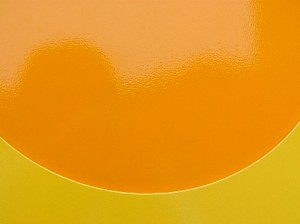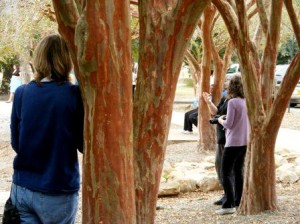Tuesday
Arts and PoetryParticipating in a Dance of Energies: An Interview with MaryBeth McBride
What was your first thought when you saw the word Miksang?

"Orange" - Miksang photo by MaryBeth McBride
Our Tallahassee group could barely pronounce the word Miksang. We liked the idea of Good Eye, [Miksang means Good Eye in Tibetan.] it peaked our curiosity. Ten people quickly signed up for the first ‘Contemplative Photography’ class.
Through a series of synchronicities in March, 2007, Miriam Hall of Madison, Wisconsin came to Tallahassee to teach back to back weekends in Contemplative Writing and Miksang, Level I. It was an amazing week of practice. There were two people who had never picked up a camera before in their lives, two professional photographers, two self-identified family-photo photographers and many skill levels in-between. Those who had previous training in photography, had to deconstruct back to beginner mind. Those who had no skill had to let go of insecurities. All had to work with performance anxiety when the time of review arrived.
In Tallahassee we fell in love with the practice of Miksang in 2007. We met once monthly for a shoot, picking a different place and a different form [color, surface, light/shadow, space/ dot-in-space]. We would photograph our assignment for an hour, then review our work for an hour. We did this for a full year.
And in Spring 2008, hungry for more training, we responded to Miriam Hall’s encouragement to host the East Coast 2008 Teacher Training in Tallahassee. John McQuade, one of the founders of Miksang instruction, graciously traveled to Tallahassee and provided instruction to a group of twelve participants that arrived from all over the United States.
Are there photographers that tend to influence or inspire your photography?
The most heart touching moment of our training has been when Louise Ritchie, a Miksang student exclaimed, ‘I am seeing the beauty of the world for the first time,” Louise recently had one of her Miksang photos selected by YES magazine for print in one of their magazine articles. The student is now a published artist. That’s inspiration.

"Sentient Miksangers" - Miksang photo by MaryBeth McBride
What has changed for you (or not) now that you have studied this art form?
Teaching Miksang is another precious element of my life. I think I speak for my Tallahassee co-teachers. We feel profoundly honored and grateful to receive these teachings from John McQuade so early in our practice. Nervous about teaching, but with John’s encouragement, we taught our first class in Summer 2008. The opportunity to extend this magical gift to others, felt very precious. Our own understanding and practice has deepened. Our spirits soar when we observe the students gasp at the beauty unfolding in their camera’s lenses and on the screen at review sessions.
Now, to my delight, Good Eye is always with me, whether I have my camera or not. No matter where I am, my eye, brain, heart, and body can, in a glance catch a ‘snap shot’ of essence : seeing clearly the shadow of my desk chair on the wall, the curve of grey hair on a withered cheek, the pattern on the air-conditioner grill,these perceptions melt my heart. With awareness, I see the deep green of the trash container, and observe the rusty round handle in the middle of that deep green. I move from color and space to ‘dot in space’, and take in the beauty of this ordinary element in my world.
What is the connection between mind and lens?
Now, just as on the cushion, my obstacles do arise. Rushing, searching and sharp focus, critical thoughts about my abilities, not feeling like my photos will be good enough are just a few of the familiar obstacles. But I have this practice, and in a blink of softened eye, I breathe out and connect with my world through my camera lens.
With Miksang, I always feel like I am participating in a dance of energies with whatever I am photographing. I am present for that “flash of perception”, for that moment of pure appearance arising before me. This is where the deep teaching of dharma comes through for me. Before Miksang, these were just words on page. I believed them, but I had not experienced them. With Miksang, because the practice is so direct, and so non-intellectual, I receive these teachings directly. The world is teaching me. It is very powerful.
I find Miksang to be a profound vehicle for dharma teaching. First, there is the almost immediate synchronization of body/mind/spirit. I can sit on the cushion for a long time with mind chatter keeping me tense and separate from the present moment. When I go out on a shoot, I set my intention to focus on color, for instance. I walk with soft focus until my attention is caught by color. I raise my camera, and shoot. In the process, through my lens, when I am just focused on color, the deep colorful essence of the object penetrates my eye, penetrates my heart. There is a relaxation and an “Ahhhh” that happens during every shoot. I fall in love with the world that is right there outside my door. There is no separation. I am drawn into the color, the surface, the light and shadow with no story line attached. I am touched by the essence.
MaryBeth McBride is a member of the Tallahassee Shambhala Study Group in Florida and Miksang instructor.
















